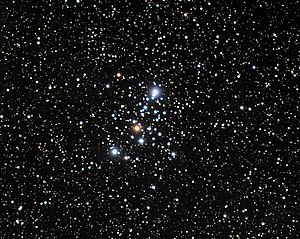Messier 103
| Messier 103 | |
|---|---|
 Open cluster Messier 103 in Cassiopeia | |
| Observation data (J2000.0 epoch) | |
| Right ascension | 01h 33.2m |
| Declination | +60° 42′ |
| Distance | 9,400 light-years (2.884 ± 0.313 kpc[1]) |
| Apparent magnitude (V) | 7.4[2] |
| Apparent dimensions (V) | 6.0' |
| Physical characteristics | |
| Estimated age | 12.6 ± 0.2 million years[1] |
| Other designations | NGC 581, Cr 14 |
| Associations | |
Messier 103 (also known as M103, or NGC 581) is a small open cluster of many faint stars in Cassiopeia. It was discovered on 20 September 1781 by Pierre Méchain, but later added as Charles Messier's last deep-sky object in his catalogue.[3]
It is located between 9400 light-years from the Sun[1][3] and is about 15 light years across. It holds two prominent stars, of which the brightest is magnitudes 10.5, and in the center of the cluster, a magnitude 10.8 red giant. Another bright foreground object is the double star Struve 131,[4] but is not a member of the cluster. Cluster membership is about 172 stars based on >50% probability of gravitational attachment that binds the cluster together.[4] M103 is between 12.6[1] to about 22 million years in age.[5]
Observation history[edit]
After the discovery of Messier 101 through 103 by Pierre Méchain, Messier later added this open cluster to his own catalogue.[4][6] In 1783, William Herschel described the region of M103 as 14 to 16 pL (pretty large stars) and with great many eS or extremely faint ones.[7] Åke Wallenquist then identified 40 stars in M103 while Antonín Bečvář raised this to 60. Archinal and Hynes suggest that the cluster has 172 stars.[4] Admiral William Henry Smyth pointed out the cluster's 10.8-magnitude red giant, citing it was a double star on Cassiopeia's knee, about 1° northeast of Delta Cassiopeiae, sometimes called as Ruchbah or Rukhbah.
Telescopic View[edit]
Messier 103 is an easy object to find[8] and the cluster is visible in binoculars or a small telescope.[9] object to find and the cluster is visible even with the use of binoculars.[4][10] M103 can be seen as a nebulous fan-shaped patch, and is about a fifth the apparent diameter of the Moon or 6 arcminute (6′) or 0.1° across. To find M103, it is suggested that the observer center on Ruchbah or the lowest star of the signature “W” asterism of Cassiopeia. The cluster will appear as a hazy patch in a field about 1⁄3 the length of an imaginary line towards Epsilon Cassiopeiae, a northern endpoint of the 'W', and placed on the outer side of the 'W'.
Gallery[edit]
-
M103 image from Aladin Sky Atlas
-
Finder chart for M103
See also[edit]
References and footnotes[edit]
- ^ a b c d Sanner, J.; Geffert, M.; Brunzendorf, J.; Schmoll, J. (1999). "Photometric and kinematic studies of open star clusters. I. NGC 581 (M 103)". Astronomy and Astrophysics. 349: 448–456. arXiv:astro-ph/9908059. Bibcode:1999A&A...349..448S.
- ^ "Messier 103". SEDS Messier Catalog. Retrieved 30 April 2022.
- ^ a b Robert Bruce Thompson [1], M103 (open cluster in Cassiopeia). Accessed online 13 April 2011
- ^ a b c d e "Messier 103: Observations and Descriptions". SEDS. Retrieved 13 April 2011.
- ^ Huang, W; Gies, D.R.; McSwain, M.V. (2010). "A stellar rotation census of B stars: from ZAMS to TAMS". Astrophysical Journal. 722: 605–619. arXiv:1008.1761. Bibcode:2010ApJ...722..605H. doi:10.1088/0004-637X/722/1/605. S2CID 118532653.
- ^ "3 Clusters in Cassiopeia". One Minute Astronomer. Archived from the original on 22 February 2011. Retrieved 14 April 2010.
- ^ "Messier 103". Universe Today. 7 January 2010. Retrieved 14 April 2010.
- ^ "Messier 103". Perez Media. Retrieved 14 April 2010.
- ^ "Messier 103". Perez Media. Retrieved 14 April 2010.
- ^ "The Constellation Cassiopeia". Zimbio. Archived from the original on 11 October 2012. Retrieved 14 April 2010.
External links[edit]
- Open Cluster M103 @ SEDS Messier pages
- Open Cluster M103 @ Skyhound.com
- NASA Astronomy Picture of the Day: Distant Open Cluster M103 (7 February 2001)
- Messier 103 on WikiSky: DSS2, SDSS, GALEX, IRAS, Hydrogen α, X-Ray, Astrophoto, Sky Map, Articles and images



